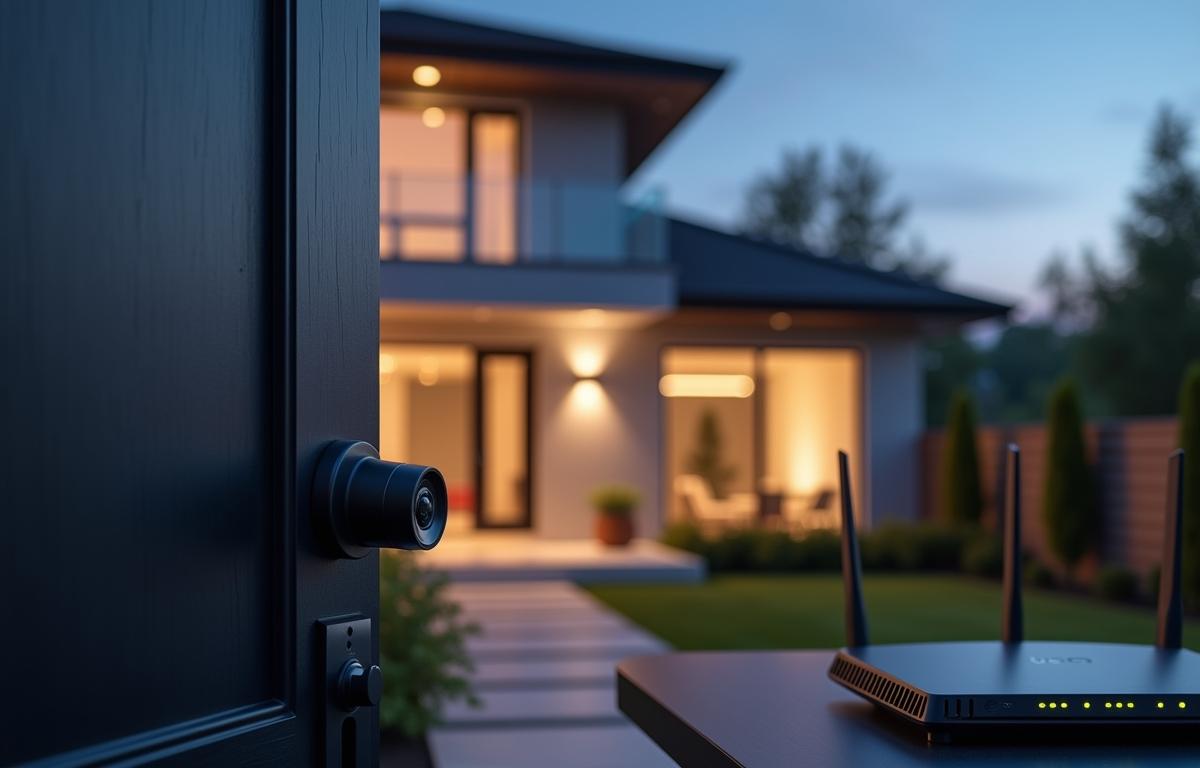Many homeowners now prioritize protecting their families and possessions with smart home security. With so many new technologies emerging, it’s easy to feel overwhelmed by the options. Yet, the ability to monitor and control so many aspects of your property at any time can bring immense peace of mind. This article invites you to explore effective ways of fortifying your home in a way that feels both manageable and reliable.
When you begin to look at all the connected gadgets growing under your roof, it becomes clear that security goes far beyond locking the front door. It’s about layering protection in ways that deter digital threats and physical intrusions alike. By following a few key practices, you’ll be on your way to creating a robust defense system that meets the demands of modern living.
Establish A Strong Network Structure
Protecting your home network is one of the first and most crucial moves you can make. After all, if someone gains remote access to your devices, they’ll have an open door to your private data and even control over certain aspects of your home. A sturdy network setup underpins every aspect of smart home security, so this step deserves plenty of attention.
Select a Secure Router
Opt for a router that supports the latest encryption protocols, typically WPA3 if available. Encryption scrambles your Wi-Fi traffic, reducing the chance that outsiders can intercept your information. Whenever you see options to update your router firmware, take advantage and stay current with the manufacturer’s security patches.
Separate Guest Access
A dedicated guest network can safeguard your primary system from accidental breaches. When visitors or service providers need a connection, offer them this isolated network so your core devices remain hidden. Modern routers usually offer simple options for creating separate SSIDs, which can be toggled on and off.
Use Strong Passwords And Authentication
Passwords are the keys to your digital castle. Short or predictable passwords are all too easy for attackers to crack. Strengthening authentication procedures keeps your entire smart home ecosystem more robust in the face of hacking attempts.
Consider using passphrases that are unique for each of your devices. A blend of letters, numbers, and symbols is vital, but you can also incorporate distinct words to make them easier to remember. If possible, set up two-factor authentication on platforms that support it. This layer requires a second code from an app or text message, making unauthorized access far more difficult.
Maximize Benefits Of Smart Cameras And Video Doorbells
Internet-connected cameras have revolutionized how people watch over their homes. They can capture suspicious activity, let you check on deliveries, and even serve as a deterrent when mounted visibly. However, ensuring these devices are securely configured is just as important as installing them.
Look For Encrypted Streams
Many reputable brands encrypt their video data, preventing third parties from intercepting your camera feed. Confirm that any camera you purchase or currently own offers an option for encryption. For extra peace of mind, see if the manufacturer provides automatic firmware updates to fix potential vulnerabilities quickly.
Position Cameras Thoughtfully
Placing cameras in strategic locations like entrances and coverable blind spots can bolster your security without flooding your home with devices. Consider focusing on key access points such as your front door, back patio, and garage. Indoor cameras may be beneficial too, but weigh any privacy concerns and store your feeds securely, either locally on a DVR or through a trustworthy cloud service.
Embrace Cybersecurity Measures For All Connected Devices
Everyday appliances such as smart thermostats, lighting systems, and even refrigerators create digital footprints. These connected systems streamline life, but each addition also brings potential cybersecurity challenges. By routinely addressing vulnerabilities, you ensure that every part of your network remains protected.
If you happen to own devices from different manufacturers, it’s worth reviewing each one’s security settings. Some apps allow you to change default passwords or limit data collection practices. Pay attention to how frequently the device producers release updates. Regular patches and improvements indicate that the brand is actively committed to secure smart home solutions.
Install Smart Locks With Care
A smart lock adds convenience and can play an integral role in your overall home protection strategy. Being able to lock and unlock doors remotely can be particularly handy if family members forget their keys or if you need to allow limited access to certain guests. Before selecting a smart lock, keep a few considerations in mind.
Check whether the lock integrates seamlessly with your existing hub or security system. Also, confirm if it supports advanced features like logging access attempts or generating alerts when someone enters. If the lock you choose relies on Wi-Fi, secure it with a unique password. For locks that use Bluetooth communications, keep your phone’s software up to date. Simple steps can drastically reduce potential vulnerabilities.
Protect Your Home’s Perimeter And Entry Points
Sensors on doors and windows might not sound exciting, but they form an essential layer of defense. These small devices can trigger alerts whenever an entry point is opened. Some systems even let you configure triggers that activate cameras or lights. By tying your sensors into a broader smart home security network, you immediately know if someone tries to get inside unexpectedly.
Additionally, motion sensors outside can turn on floodlights or send phone notifications when movement is detected. Criminals often avoid well-lit properties, and the mere act of a sudden light can deter them. For detached garages or sheds, consider installing specialized sensors there too. You’ll gain full-house awareness without much added cost.
Explore Home Automation Scenes
Certain smart home platforms let you create scenes, which are essentially automated routines. For instance, you can set a rule that arms your security system when you turn off the bedroom lights. These automation sequences are handy for eliminating human error, saving you from forgetting critical steps like locking doors at night.
Don’t Underestimate Simple Upgrades
Even with high-tech gadgetry, never neglect tried-and-true methods such as sturdy door frames, deadbolts, and good window locks. These improvements often cost less but still make an enormous difference in overall protection. A layered approach combining both high-tech and low-tech solutions is typically the most effective.
Back Up And Encrypt Important Data
Safeguarding physical property is only part of the picture. You may have personal documents, work files, or family photos stored digitally on your devices or in the cloud. If a cybercriminal gains access to these files, the consequences can extend well beyond a simple breach. It’s a good practice to backup all critical data to external drives or reputable cloud services.
Look for encryption tools that can scramble data at rest, making it unreadable if someone steals a hard drive or gains unauthorized access to your cloud storage. Many operating systems now include built-in encryption for local discs. For cloud solutions, choose a provider that explicitly states how they protect uploaded files. These measures ensure you don’t lose important information, even if your network is compromised.
Integrate Regular Maintenance Checks
Regular maintenance and checkups should become part of your routine. Devices that run outdated software can contain vulnerabilities that developers have already patched. Simple steps like rebooting your router and checking for system updates help keep everything running efficiently. Don’t forget to replace batteries in sensors, cameras, and smart locks to avoid losing functionality.
Create A Monthly Checklist
A monthly security review can become second nature. This review could include scanning for software updates, validating that cameras and sensors remain functional, and reviewing user permissions for family members. While not a glamorous task, a short checklist helps you spot small issues before they escalate into major problems.
Monitor Device Permissions
A system often expands as you add new gadgets or let friends control lights or thermostats. Over time, you might forget who has access to specific devices. Reviewing user permissions helps prevent unauthorized parties from snooping around in your home network. Remove anyone who no longer needs access, and change passwords regularly.
Employ Security-Focused Practices In Daily Life
Smart home security begins with the habits you form each day. Even the most advanced system can’t protect you if you routinely ignore alerts or remain unaware of potential threats. Familiarize yourself with the warning signs of suspicious online behavior and know how to respond. Pay attention to phishing attempts and never give out private information unless you’re absolutely sure of the recipient’s identity.
Communicate With Household Members
Everybody in the home should understand why it’s important to follow certain procedures. Emphasize the ideas of strong passwords and safe browsing, so you don’t become vulnerable through a simple oversight. Demonstrating a shared commitment to security ensures that you’re not the only one keeping an eye out. Collectively, the household can spot suspicious activity early and take swift action.
Consider Professional Guidance
If you ever feel overwhelmed by the technical details, you have the option of enlisting professional support. Security consultants, reputable home automation firms, and local specialists can offer sound advice tailored to your property. Whether it’s for an initial setup or periodic reviews, a professional perspective can sometimes uncover risks you might have missed.
Stay Vigilant And Proactive
While innovation introduces colorful gadgets and impressive convenience, it also requires homeowners to step up their security efforts. The digital landscape evolves quickly, and criminals constantly find new exploits. Maintaining a watchful eye on emerging trends will help you recognize potential threats early.
Remember that investing in tools and practicing good habits go hand in hand. This dual approach is the best way to keep your property and loved ones safe. Every device, from the smallest sensor to the most advanced doorbell, contributes to a collective shield around your home. By combining practical measures with everyday vigilance, you’ll create a safety net that stands strong against the evolving challenges of modern life.




